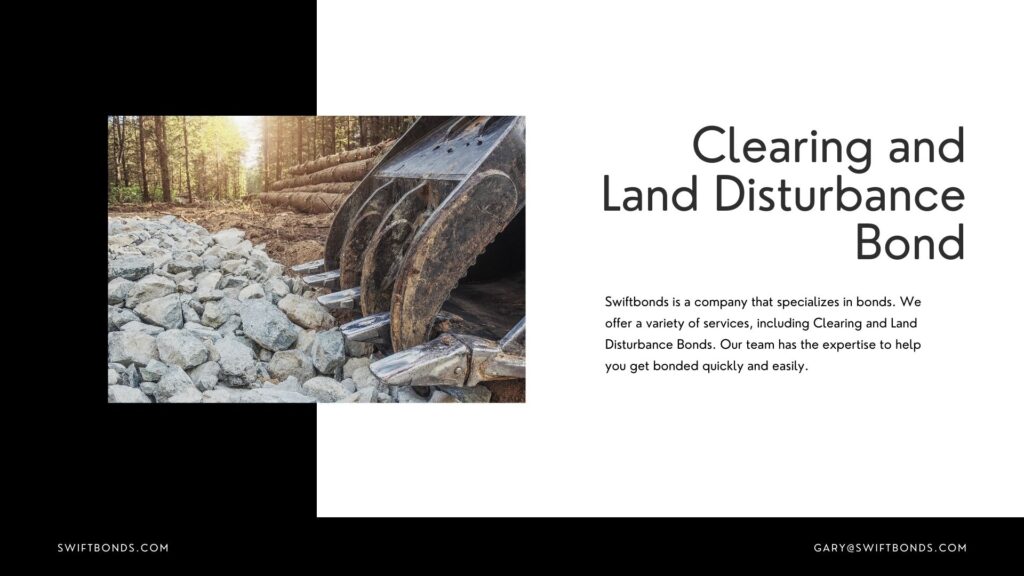
Get An Instant Quote on Irondale, AL-Clearing and Land Disturbance Bond Now

Introduction
In the scenic city of Irondale, AL, the balance between development and environmental preservation is of paramount importance. As construction projects and land development activities continue to shape the landscape, measures must be taken to mitigate the impacts of clearing and land disturbance. One such measure is the Clearing and Land Disturbance Bond, mandated by city authorities to ensure responsible development practices. In this article, we explore the intricacies of the Clearing and Land Disturbance Bond in Irondale, shedding light on its purpose, requirements, and implications for developers and the environment.

Understanding the Purpose
The Clearing and Land Disturbance Bond serves a fundamental purpose in protecting Irondale's natural resources and promoting sustainable development practices. By requiring developers to obtain this bond, the city aims to minimize the adverse impacts of land clearing and construction on soil erosion, water quality, and wildlife habitats. Additionally, the bond helps ensure compliance with stormwater management regulations and safeguards against environmental degradation. Ultimately, it fosters responsible land use practices and preserves the ecological integrity of Irondale's landscapes.
Requirements and Application Process
Obtaining a Clearing and Land Disturbance Bond in Irondale involves meeting specific criteria set forth by city authorities. Developers typically undergo a thorough application process, which may include environmental assessments, erosion control plans, and financial documentation. Additionally, they must secure the bond from a licensed surety company, with the bond amount determined based on factors such as the size and scope of the development project. By fulfilling these requirements, developers demonstrate their commitment to environmental stewardship and sustainable development in Irondale.
Implications for Developers and the Environment
For developers, the Clearing and Land Disturbance Bond carries significant implications for their projects and responsibilities. It serves as a prerequisite for obtaining permits and approvals from the city and influences the overall design and execution of the development. Failure to maintain compliance with the bond requirements can result in fines, penalties, and delays in project completion. Conversely, for the environment, the bond helps minimize habitat loss, protect water resources, and maintain the ecological balance of Irondale's landscapes.
Conclusion
As Irondale continues to experience growth and development, the Clearing and Land Disturbance Bond remains a vital tool in preserving the city's natural resources and promoting sustainable land use practices. By understanding its purpose, meeting the requisite requirements, and embracing its implications, developers can contribute to the long-term environmental health and vibrancy of Irondale. In doing so, they help ensure that future generations can enjoy the beauty and benefits of Irondale's landscapes for years to come.
What is the Irondale, AL – Clearing and Land Disturbance Bond?
The Clearing and Land Disturbance Bond is a crucial component of Irondale's regulatory framework for land development projects. But what exactly does this bond entail? Essentially, it is a form of surety bond required by the city to ensure that developers adhere to all relevant laws, codes, and regulations while clearing land and undertaking construction activities. By obtaining this bond, developers provide financial security to cover potential liabilities or damages that may arise from their activities.
Frequently Asked Questions
Can the Clearing and Land Disturbance Bond Cover Costs Associated with Habitat Restoration and Enhancement?
An uncommon question that may arise among developers in Irondale regarding the Clearing and Land Disturbance Bond concerns its coverage for habitat restoration and enhancement costs. Developers may wonder whether the bond extends to cover expenses related to restoring or enhancing wildlife habitats impacted by land clearing and construction activities. This could include the replanting of native vegetation, the creation of wetlands or wildlife corridors, or the installation of habitat structures. The answer depends on the specific terms outlined in the bond agreement and the regulations set forth by the city. While some bonds may offer coverage for habitat restoration and enhancement efforts, others may require additional endorsements or separate bonds for such purposes. Developers should consult with their surety bond provider or city officials to clarify the coverage for habitat restoration and enhancement costs.
Are There Provisions for Bond Reduction or Release Based on Successful Implementation of Environmental Mitigation Measures?
Another less common inquiry pertains to the provisions for bond reduction or release based on the successful implementation of environmental mitigation measures under the Clearing and Land Disturbance Bond in Irondale. Developers may inquire whether they can receive a partial reduction or release of the bond amount upon demonstrating compliance with environmental mitigation requirements and the successful completion of habitat restoration or erosion control measures. Additionally, they may wonder if the bond can be released in stages as specific milestones of environmental mitigation are achieved during the project lifecycle. The applicability of bond reduction or release provisions often depends on the specific terms outlined in the bond agreement and the regulations set by the city. Developers should consult with their surety bond provider or city officials to determine if such provisions are available and applicable to their situation.
Can the Clearing and Land Disturbance Bond Extend to Cover Expenses Related to Invasive Species Management?
A lesser-known aspect that developers may inquire about is the extension of coverage under the Clearing and Land Disturbance Bond to include expenses related to invasive species management. Developers may wonder whether the bond can provide coverage for costs associated with controlling or eradicating invasive plant species that may proliferate following land clearing activities and threaten native ecosystems. The applicability of coverage for invasive species management often depends on the specific terms outlined in the bond agreement and the regulations set by the city. Developers should consult with their surety bond provider or city officials to determine the bond's coverage for invasive species management expenses and ensure compliance with environmental regulations.
